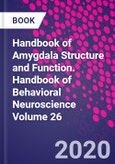Handbook of Amygdala Structure and Function, Volume 26, provides an updated overview on the functional neuroanatomy of amygdala nuclei, with an emphasis on interconnections (basolateral, central amygdala, medial amygdala) and their integration into related networks/circuits (prefrontal cortex, bed nucleus, nucleus accumbens). The design of this volume builds upon the foundations of functional neural circuits and the corresponding (cellular) electrophysiology important for the homeostatic control of amygdala function. This volume contains a dedicated section on the anatomical organization of the amygdala nuclei, emphasizing the role of neurotransmitters and neuropeptides that integrate signals and regulate behavior.
Additional chapters discuss cellular physiology, plasticity and the integration of electrical signals that contribute to neural activity. The final section of the book connects the role of amygdala dysfunction and the development of disorders in human health and disease.
Please Note: This is an On Demand product, delivery may take up to 11 working days after payment has been received.
Table of Contents
1. Functional Neuroanatomy of the Basolateral Amygdala: Neurons, Neurotransmitters, and Circuits 2. The Medial Amygdala: Structure and Function 3. Amygdala Neuron Subtypes Based on Genetics, Physiology and Anatomy 4. Amygdala physiology in pain 5. Neural Plasticity of the Amygdala 6. Plasticity of amygdala neurons underlying fear learning and extinction 7. Neuropeptide Y and Amygdala Circuitry: Modulation of Stress Behaviors 8. The Amygdalar Opioid System 9. Noradrenergic Regulation of the Basolateral Amygdala 10. Pituitary Adenylate Cyclase-Activating Polypeptide (PACAP) in Stress, Pain, and Learning 11. Protect and Harm Effects of Stress on the Amygdala 12. Sex Differences in Amygdala Structure and Function: From Rodents to Humans








